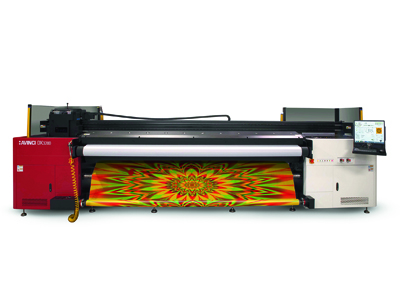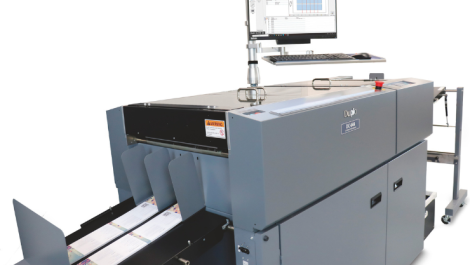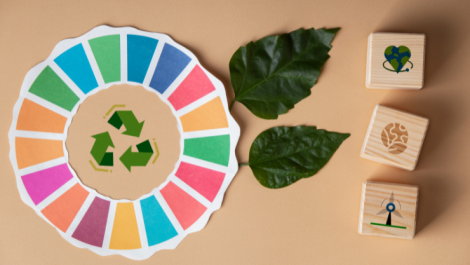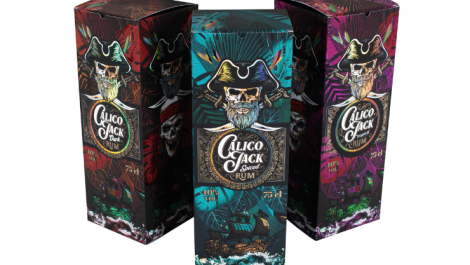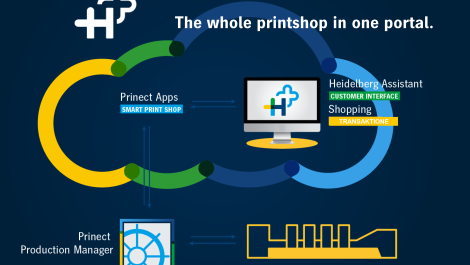Agfa’s Avinci DX3200 is a dye-sublimation model for high volume printing of soft signage and other textile applications
Roll-fed printers are the bedrock of the wide-format sector, and their applications keep on growing. Michael Walker takes a look at what’s available, from the entry level to the serious production workhorses.
Roll-fed wide-format printers cover a huge and growing range of applications, from proofing for litho print to posters, signage staples such as banners, decals and soft signage, display, floor and window graphics, vehicle and building wraps, and increasingly textiles for décor or garment use and dye-sublimation onto a variety of suitably treated surfaces. They also come in a range of sizes from just over a metre (typically sold as “48in” models, offering around 1200mm) up to three- and five-metre super wide-format offerings, with output speed anywhere from a few square metres per hour to hundreds and price tags ranging from the low thousands into the millions.
There’s a handful of ink technologies that enables this versatile class of device to suit so many substrates and applications. One of the oldest is solvent, now almost entirely replaced with eco-solvent varieties that emit less of the potentially harmful VOCs (volatile organic compounds) and so require less in the way of dedicated ventilation for safe operation but still tend to require an outgassing period after printing and before shipping or fitting. Because the solvent penetrates the substrate (typically vinyl, paper or banner material) and carries the colourants into the material it forms a durable lasting image suitable for outdoor applications, and solvent-based printing is one of the most cost effective options. Aqueous (water-based) inks have also been around for a long time, and tend to be used in printers with high resolutions and wide colour gamuts for photographic and other high quality display work destined for controlled indoor conditions.
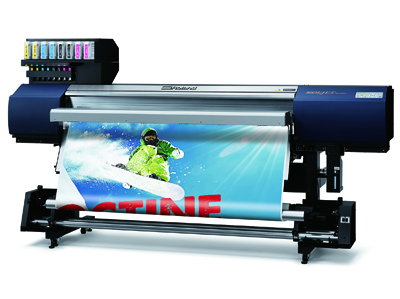
The EJ-640 from Roland DG is aimed at high volume signage applications
More recent additions are Latex, championed by HP, though also available from Mimaki and Ricoh, and UV-curable, though the latter is perhaps more usually found in flatbed applications, which we’ll be looking at next month. Latex doesn’t have the harmful VOCs of solvent varieties but being water-based does require quite a lot of energy for drying, though once dry, prints are ready for further treatment or use. UV-cured inks form a plastic film so are tough and therefore suited to outdoor applications and in the most recent variety of LED-curing devices, require low energy for curing and are instantly dry; the reduced curing heat also allows UV printing on thinner or more heat-sensitive substrates. For roll-fed applications, the cured ink layer has to be thinner or more flexible to avoid cracking when rolled; “solvent UV” inks aim to combine the thinner ink film and visual properties of solvent with the fast curing of UV.
Dye sublimation is another technology that’s actually been around since the early 1990s but was supplanted in photo printing by aqueous inkjet advances. It’s been enjoying quite a renaissance in recent years as it works very well with textile printing, both for soft signage, and now for décor applications such as soft furnishing and wallcoverings. Hard objects with suitable polyester surface treatment have been printed for many years using this process, also yielding very rich saturated colours. The process usually involves printing to a transfer paper that then sublimes the solid ink into the substrate via a heat press, though there are some direct-to-textile sublimation textile printers available, usually in the higher performance (and cost) category.
Agfa Graphics last year completed its transition to LED UV-curing in all its wide-format printers. It offers two 3.2m width roll-fed machines and one hybrid: the Jeti Ceres RTR3200 LED and the Anapurna H3200I LED (hybrid) for general work and Avinci DX3200 for soft signage.
The Jeti Ceres model, aimed at mid- to high-end productivity applications, is able to print on a diverse range of single and dual-roll media at up to 186sqm/hr, and supports dual-sided printing for backlit or block-out applications and has a white ink option. The Avinci DX3200 is a dye-sublimation printer that can run at up to 173sqm/hr and offers resolutions of up to 1440 x 540dpi for soft signage and other polyester-based applications. All Agfa printers use the company’s wide gamut UV ink set, which in conjunction with the Asanti workflow software, is said to minimise ink consumption.

Epson’s SureColor range includes printers for signage, textiles and high quality photo and proofing applications like this SC-P20000
Canon delivered a new imaging technology last year with the launch of the Océ Colorado 1640. Aimed at signage applications, though not necessarily soft signage, the 1640mm width Colorado offers productivity up to 177sqm/hr, with various automation features and resolutions up to 1800 x 600dpi, while using 40% less ink than “competing” technologies, according to Canon. The “pinned” gel ink dots are cured by a UV LED array, which allows thinner and more heat-sensitive media to be used, as well as providing good adhesion to textured media such as non-slip floor graphics, requiring no lamination. With orders in 2017 expected to reach 500 units, it’s clear that Canon regards UVgel as a key technology and we expect to see additions to the range later this year.
Durst plays at the heavy end of the sector, with three- and five-metre printers the 312Plus and 512Plus capable of very high throughput – up to 400sqm/hr at “usable” quality from the 512 while a Fine Art printing mode offers 1200dpi. Additional colours are available including CocaCola red for brand colour matching as well as light cyan, magenta and black for smoother gradients. Productivity features enable unattended operation and a V-cut option with extended knife life for increased uptime.
The Rhotex 325 is Durst’s entry in 3.2m width textile print. It uses the company’s Water Technology inks for improved environmental credentials either direct or via transfer paper and can print at up to 390sqm/hr in up to eight colours. It can be loaded with jumbo rolls suitable for 15,000sqm of output. This is supported by remote control and analytics functions, areas that the company is developing further this year.
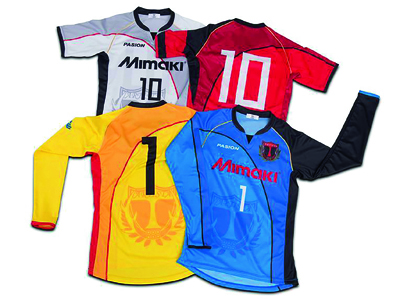
Mimaki textile printers can produce vibrant results on polyester fabrics using Eco Passport-certified inks
EFI’s Vutek range also includes high quality high productivity models. The Vutek 3r is a 3.2m LED machine that offers true 1200dpi resolution, automated registration for backlit applications and throughput of up to 345sqm/hr (though not at the same time). Its productivity features include an inline finishing system for x-cutting, slitting and collating output. White and “light” inks are also available.
A five-metre version, the Vutek 5r, is also available, which offers up to 455sqm/hr printing with similar resolution, automation and ink options, while using less ink and energy than alternatives, according a Hungarian customer. EFI’s inks for both models provide high flexibility to match the substrates and through collaboration with 3M, are available in variants that offer the MCS warranty on outdoor and fleet and vehicle graphics when used with appropriate media and overlaminates.
Epson’s SureColor range of roll-fed printers come in widths up to 64in (1.6m) and families for signage (eco-solvent SC-S prefixed models), proofing, fine art and photography (aqueous inks, SC-P range) and fabric/textile applications (the dye-sublimation SC-F series). UK sales manager Phil McMullin believes that eco-solvent is making something of a comeback after the “long shadow” cast by previous solvent drawbacks, and points to the wide colour gamut that the 10-colour flagship SC-S80600 printer can achieve – 98% of the Pantone range – in vinyl applications including vehicle wraps. On the textile side, he says a “re-shoring” of fashion clothing production based around small quantities and short lead times is opening up opportunities, especially as polyester materials now successfully mimic many other fabric types; interior décor is another expanding market that is still in its infancy, with digital print accounting for around just 3-4% of production.
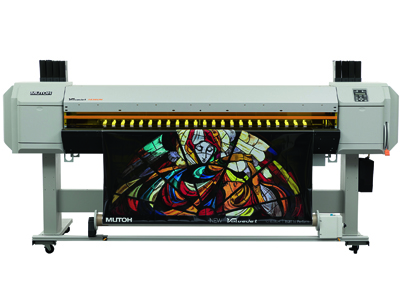
The ValueJet 1638UH from Mutoh is a hybrid model that supports roll-fed printing and rigid media
Fujifilm rebadges the Océ Arizona flatbeds but also offers the Acuity LED 3200R, a 3.2m roll-fed machine that produces high quality output at up to 60sqm/hr but also has a productivity mode running at 110sqm/hr. There’s also a 1.6m hybrid, the Acuity LED 1600 II, which supports up to eight colours including white and clear for backlit and special finish applications. It runs at up to 33sqm/hr.
Marketing manager Mike Battersby comments that the two machines are being used for applications outside typical signage and display, such as wallpaper printing, short-run and prototype packaging, and even industrial uses like membrane switch overlays that previously required laborious screen printing. ‘All of these sectors show very strong future growth potential. In 2018 Fujifilm will be announcing new developments to build on the success of its roll-fed Acuity range,’ he comments.
HP has a well-established family of Latex printers with some 1400 installations worldwide since the introduction of the technology in 2009. The most recent is the Latex 115, an entry-level model that’s also offered in a print-and-cut version with a package price of under £11,000. Improvements in Latex ink mean that the one printer can cover a number of applications, from vinyls, banners and paper to soft signage and interior décor, including soft furnishings.
HP’s Mike Horsten points out that through use of the same ink set and colour management, smaller printers such as the 115 produce output identical to that from larger and faster Latex models, allowing its use for samples as well as for small scale production. He claims its productivity compares very well against dye-sub alternatives, while its print-then-cut model offers better resilience to faults than competing print-and-cut devices.
Mimaki offers roll-fed printers for most applications but its current focus is largely on textiles. The TS30-1300 is an entry-level sublimation printer that uses Mimaki’s Eco Passport-certified inks. It prints to a width of 1.3m at up to 20sqm/hr onto polyester fabrics and coated objects (with a suitable heat press). Fespa 2017 also saw the introduction of the Tx300P-1800, a direct-to-textile dual-ink model that holds both pigment and sublimation inks to allow a single printer to output to the widest range of fabric types without changing inks. High productivity is catered for with the 390sqm/hr Tiger 1800B model, a result of Mimaki’s acquisition of La Meccanica.
Conventional print and cut signage and display applications are supported by the UCJV range, launched in autumn 2017. The 1.6m LED UV printer is available in two versions and is claimed to have very low running costs.
Mutoh offers printers for sign and display (served by hybrid models like the ValueJet 1638UH, see next issue), speciality/industrial, digital transfer and direct textile printers. For high volume textile and décor applications, the ValueJet 1948WX is a 1.9m dye sublimation transfer printer that features a staggered four printhead array and built-in dual heaters to yield printing speeds from 67sqm/hr at 720 x720dpi in four-pass (top quality) mode to 125sqm/hr (360 x 720dpi, two-pass) and a maximum of 194sqm/hr.
Direct textile printing offered by the VJ-1938TX, also a 1.9m printer, specifically targeted at short run on-demand production. It uses aqueous or direct sublimation inks and can handle fabric rolls up to 100kg and prints at up to 40sqm/hr. The ValueJet 1638X is a fourth generation sign and display printer with dual heads and 1.6m width, suitable fora wide range of applications, offering “sellable” 720 x 720dpi production at up to 36sqm/hr.
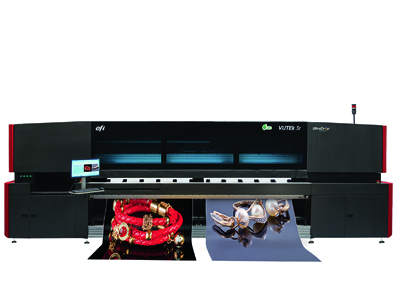
Three- and five-metre machines like this EFI Vutek 3r can be configured to print more than one roll at a time
Ricoh has the Pro L4100 Series, which prints to a width of 1371mm and uses Ricoh’s own “aqueous resin inks” – a form of latex – to produce durable prints for indoor and outdoor use in typical signage and display applications including metallic and transparent vinyl, PET films, backlit media and polyester substrates. More unusually, the L4100 is said by Ricoh to be the first latex printer to be certified for use with the Color-Logic metallic and decorative effects printing system. This allows metallic colour effects to be achieved without requiring specialist additional equipment.
Roland DG offers machines up to 64in (1.6m) with eco-solvent, UV, dye-sublimation and solvent UV inks. In addition to standard four-colour printers, the company offers speciality inks such as white, metallic, fluorescent and clear gloss. It’s known for its combined print-and-cut models, including the TrueVIS VG and SG series and Soljet Pro 4 XR-640 which meet various requirements and budgets, but also has various print-only models such as the VersaExpress RF-640, Soljet EJ-640 High Volume Printer. For textile printing, there’s the Texart XT-640 and RT-640 dye-sub models for personalised products and apparel applications.
Head of sales Rob Goleniowski comments, ‘Applications across floors and walls and window graphics both internally and externally will be key trends this year. Integrating hardware with a customer-focused website [or] app will become more common place as printers look to automate some of their design services.’
